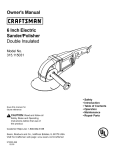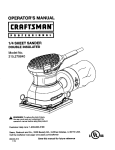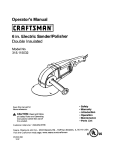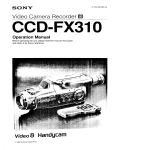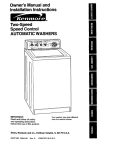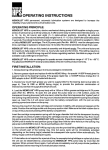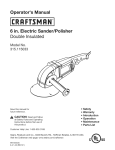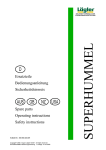Download Craftsman 315.115030 Owner`s manual
Transcript
SE/ S OWNER'S MANUAL MODEL NO. 31.5.115030 Caubon: Read and Follow CRRFTSMRN° All Safety Rules and Instructions Before Operating This Equipment. 6 Inch Electric Sander/Polisher Thank You for Buying A Craftsman Sander/Polisher Double Insulated Rules For Safe Operation Introduction and Warranty Table of Contents Operation Maintenance Repair Parts Sold by SEARS, ROEBUCK AND CO. Hoffmsn Estates, 972000-136 8-00 ® IL 60179 U.S.A. Printed In U.S,A. RULES FOR SAFE OPERATION DOUBLE INSULATION is a safety concept in electric power tools, which eliminates the need for the usual three wire grounded powercord and grounded supplysystem. Wherever there is electric current in the tool there are two complete sets of insulation to protect the user. All exposed metal parts are isolated from internal metal motor components with protecting insulation. IMPORTANT -- Servicing of a tool with double insulation requires extreme care and knowledge of the system and should be performed only by a qualified service tecnhician. For service we suggest you return the tool to your nearest Sears Store for repair. Always use originalfactory replacement parts when servicing. WARNING: WARNING: The double insulated system is intended to protect the user from shock resulting from a break in the tool's internal wiring. Observe all normal safety precauhons related to avoiding electrical shock. Do not attempt to operate this tool until you have read thoroughly and understand completely all instructions, safety rules, etc. contained in this manual. Fa=lure to comply can result in accidents involving fire, electdc shock, or senous personal injury. Save owner's manual and review frequently for continuing safe operation, and instructing others who may use this tool. READ ALL INSTRUCTIONS 1. KNOW YOUR POWER TOOL. Read owner's manual carefully. Learn its applications and lim!tationsas well as the specific potential hazards related to this tool. 2. 3. 4. GUARD AGAINST ELECTRICAL SHOCK by preventing body contact with grounded surfaces. For example: Pipes, radiators, ranges, refrigerator enclosures. KEEP GUARDS IN PLACE and in working order. KEEP WORK AREA CLEAN. Cluttered areas and benches invite accidents. 5. AVOID DANGEROUS ENVIRONMENT, Don't use power tool in damp or wet locations or expose to rain. Keep work area well lit. 6. KEEP CHILDREN AND VISITORS AWAY. All visitors should wear safety glasses and be kept a safe distance from work area. Do not let visitors contact tool or extension cord. 7. STORE IDLE TOOLS. When not in use tools should be stored in a dry, high or locked-up place - out of the reach of children. DON'T FORCE TOOL. It will do the job better and safer at the rate for which it was designed. 9. USE RIGHT TOOL. Don't force small tool or attachment to do the job of a heavy duty tool. Don't use tool for purpose not intended - for example - A circular saw should never be used for cutting tree limbs or logs. 10. WEAR PROPER APPAREL. Do not wear loose when working outdoors. Wear protective hair covering to contain long hair and keep it from being drawn into nearby air vents. 11. ALWAYS WEAR SAFETY GLASSES. Everyday eyeglasses have only impact-resistant lenses; they are NOT safety glasses. 12. PROTECT YOUR LUNGS. Wear a face or dust mask if operation is dusty. 13. PROTECT YOUR HEARING. protection during extended Wear hearing periods of operation. 14. DON'T ABUSE CORD. Never carry tool by cord or yank it to disconnect from receptacle. Keep cord from heat, oil and sharp edges. 15. SECURE work. 16. WORK. Use clamps or a vise to hold Both hands are needed to operate the tool. DON'T OVERREACH. Keep proper footing and balance at all times. Do not usa on a ladder or unstable support. 17. 8. MAINTAIN TOOLS WITH CARE. Keep tools sharp at all times, and clean for best and safest performance. Follow instructions for lubricating and changing accessories. 18. DISCONNECT TOOLS. When not in use, before servicing, or when changing attachments, blades, bits, cutters, etc., all tools should be disconnected from power supply. 19. REMOVE clothing or jewelry that can get caught in the tool's moving parts and cause personal injury. Rubber gloves and non-skid footwear are recommended Page 2 ADJUSTING KEYS AND WRENCHES. Form habit of checking to see that keys and adjusting wrenches are removed from tool before turning it on. RULES FOR SAFE OPERATION (Continued) 20. AVOID ACCIDENTAL STARTING. Don't carry plugged-in tools with finger on switch. Be sure switch is off when plugging in. • 21. MAKE SURE YOUR EXTENSION CORD IS IN GOOD CONDITION. When using an extension cord, be sure to use one heavy enough to carry the current your product will draw. An undersized cord will cause a drop in line voltage resulting in loss of power and overheating. A wire gage size (A.W.G.) of at least 16 is recommended for an extension cord 100 feet or less in length. A cord exceeding 100 feet is not recommended. If in doubt, use the next heavier gage. The smaller the gage number, the heavier the cord. 22. OUTDOOR USE EXTENSION CORDS. When tool is used outdoors,use only extension cords suitable for use outdoors. Outdoor approved cords are marked with the suffix W-A, for example - SJTWA or SJOW-A. 23. NEVER USE THIS OR ANY POWER SANDER FOR WET SANDING. Failure to comply can result in electrical shock causing serious injury or worse. 24. KEEP HANDS AWAY FROM SANDING AREA. 25. NEVER USE IN AN EXPLOSIVE ATMOSPHERE. Normal sparking of the motor could ignite fumes. 26. INSPECT TOOL CORDS PERIODICALLY and if damaged, have repaired at your nearest Sears Repair Center. Stay constantly aware of cord location. 27. INSPECT EXTENSION CORDS PERIODICALLY and replace if damaged. 28. KEEP HANDLES DRY, CLEAN, AND FREE FROM OIL AND GREASE. Always use a clean cloth when cleaning. Never use brake fluids, gasoline, petroleum-based products or any strong solvents to clean your tool. 29. STAY ALERT. Watch what you are doing and use common sense. Do not operate tool when you are tired. Do not rush. 30. CHECK DAMAGED PARTS, Before further use of the tool, a guard or other part that is damaged should be carefully checked to determine that it will operate properly and perform its intended function. Check for alignment of moving parts, binding of moving parts, breakage of pads, mounting, and any other conditionsthat may affect I A its operation. A guard orother part that is damaged should be properly repaired or replaced by an authorized service center unless indicated elsewhere in this instruction manual. 31. DO NOT USE TOOL IF SWITCH DOES NOT TURN IT ON AND OFF. Have defective switches replaced by an authorized service center. 32. INSPECT FOR and remove all nails from lumber before sanding. 33. DRUGS, ALCOHOL, MEDICATION. Do not operate tool while under the influence of drugs, alcohol, or any medication. 34. WHEN SERVICING USE ONLY IDENTICAL CRAFTSMAN REPLACEMENT PARTS. 35. pOLARIZED PLUGS.To reduce the dskof electdc shock, this tool has a polarized plug (one blade is wider than the other). This plugwill fit in a polarized outlet only one way. If the plug does not fit fully in the outlet, reverse the plug. If it still does not fit, contact a qualified electrician to install the proper outlet. Do not change the plug in any way. 36. SAVE THESE INSTRUCTIONS. Review them frequently and use them to instruct others who may use this tool. If you loan someone this tool, loan them these instructionsalso. WARNING: Some dust created by power sanding, sawing, grinding, drilling, and other construction activities contains chemicals known to cause cancer, birth defects or other reproductive harm, Some examples of these chemicals are: • lead from lead-based paints, • crystalline silica from bricks and cement and other masonry products, and • arsenic and chromium from chemically-treated lumber. Your risk from these exposures varies, depending on how often you do this type of work. To reduce your exposure to these chemicals: work in a well ventilated area, and work with approved safety equipment, such as those dust masks that are specially designed to filter out microscopic particles. Look for this symbol to point out important safety precautions. It means attention!t! Your safety Page 3 is involved. I I I INTRODUCTION CONGRATULATIONS AND THANK YOU FOR BUYING THIS CRAFTSMAN 6 INCH ELECTRIC SANDER/ POLISHER. It has been dasignad, engineered and manufactured to provide you with Sears high standard of dependability, ease of operation, and operator safaty. Properly cared for, it will give you years of rugged, trouble-free _erformance. SPECIFICATIONS: Size of Sanding Disc 6 Inches Size of Polishing Bonnet 6 Inches Horsepower Rating CAUTION: 1/2 120 Volts, 60 Hz, AC only, 4.5 AMPS Spindle Size Carefully read through this entire owner's manual before using your new sander/polisher. Pay close attention tothe Rules for Safe Operation, Wamings and Cautions. if you usa this tool propedy and only for what it is intended, you will enjoy years of safe, reliable service. FULL ONE YEAR WARRANTY ON CRAFTSMAN 1/2 Inch - 20 TPI No Load Speed 1,400 / 1,650 RPM I Your sandadpolisher has many features for making your sanding-polishing operations more pleasant and enjoyable. Safety, performance and dependability have been given top priority in the design of this tool making iteasy to maintain and operate. SANDER/POLISHER If this Craftsman Sander/Polisher fails to give complete satisfaction within oneyear from tha date of purchase, RETURN IT TO THE NEAREST SEARS STORE IN THE UNITED STATES and Sears will repair it, free of charge. Ifthis Craftsman Sander/Polisher is used for commercial or rental purposes this warranty applies for only 90 days from the date of purchase. This warranty gives you specific legal rights, and you may also have other rights which vary from state to state. Sears, Roebuck and Co., Dept. 817 WA, Hoffman Estates, IL 60179 TABLE OF CONTENTS 1. Rules for Safe Operation ............................................................................ 2-3 2. Introduction and Product Specifications ........................................................ 4 3. Warranty and Table of Contents .................................................................... 4 4 Operation .................................................................................................... 5. Maintenance 6. Notes ......................................................................................... 7. Exploded View and Parts List ................................................................. 12-13 8. Parts Ordering / Service ............................................................................... 14 and Accessories ..................................................................... 5-9 10 ,.................. 11 WARNING: The operation of any sander/polisher can result In foreign objects being thrown Into your eyes, which can result in severe eye damage. Before beginning power tool operation, always wear safety goggles or safety glasses with side shields and a full face shield when needed. We recommend Wide Vision Safety Mask for use over eyeglasses or standard safety glasses with side shields, available at Sears Retail Stores. Page 4 OPERATION WARNING: WARNING: If any parts are missing, do not operate this tool until the missing parts are replaced. Failure to do so could result in possible serious personal injury. Always wear safety goggles or safety glasses with side shields when operating your sander/polisher. Failure to do so could result in dust, shavings, loose particles or foreign objects being thrown into your eyes, causing possible serious injury, I I ELECTRICAL CONNECTION I Your sander/polisher has a precision built electric motor. It should be con nected to a power supply that Is 120 volts, 60 Hz, AC only (normal household current). Do not operate this tool on direct current (DC). A voltage drop of more than 10 percent will cause a loss of power and the motor will overheat. If your tool does not operate when plugged into an outlet, double-check the power supply. Your sander/polisher is suitable for sanding with coarse, medium, and fine grit sanding discs. When used with the polishing bonnet supplied, it can also be used as a buffer or polisher. BEFORE ATTEMPTING TO USE YOUR SANDER/ POLISHER, FAMILIARIZE YOURSELF WITH ALL OPERATING FEATURES AND SAFETY REQUIREMENTS. TWO SPEED SWITCH WARNING: See Figure 1. Your sander/polisher is equipped with a two speed switch trigger located in the rear handle. To turn ON, depress switch trigger. To turn OFF, release switch trigger. For low speed sanding or polishing, depress switch trigger halfway. For high speed sanding or polishing depress switch trigger all the way. BE SURE SWITCH TRIGGER IS IN "OFF" POSITION BEFORE CONNECTING TO POWER SUPPLY SOURCE. Do not allow familiarity with your sander/polisher to make you careless. Remember that a careless fraction of a second is sufficient to inflict severe injury. SPANNERWRENCH POLISHING BONNET SWITCHTRIGGER ;ANDINGDISC (NOT INCLUDED) AUXILIARYHANDLE Fig. 1 d Page 5 OPERATION WARNING: Your sander/polisher should never be connected to power supply when you are assembling parts, making adjustments, assembling or replacing sanding discs or bonnets, cleaning, or when not in use. Disconnecting sander/polisher will prevent accidental starting that could cause serious personal injury. LOCK-ON BUTTON See Figure 2. Your sander/polisher is equipped with a "lock-on" feature, which isconvenient when continuous operation for extended pedods of time is required. This feature can be used for both high and low speeds. To lock on, depress the switch tdgger, push in and hold the "lock-on" button located on the side of the handle, then release the switch trigger. Release "lock-on" button and your sander/polisher will continue running. To release the lockon feature, depress switch trigger and release it. AUXILIARY RUBBERDISC HANDLE CLOCKWISE See Figure 2. An auxiliary handle is packed with your sander/polisher for ease of operation and to help prevent loss of control. Any Iou of control could result In an aocldent, causing po_lble serious personal Injury. The motor housings are designed so that the auxiliary handle can be Installed on either side of the unit. TO INSTALL: 1. Fit bolt through hole in motor housing and thread into hex nut provided internally. 2. Tighten bolt and handle securely. INSTALLING OR REMOVING See Figure3. 1. Unplug your sendedpolisher. RUBBER DISC SPINDLELOCK HOLE WARNING: Fig. 3 I Failure to unplug your sander/polisher could result in accidental starting causing possible serious personal mjury. i I 2. Position the tool as shown in figure 3 and align the spindle lock hole with the two half-circle notches in motor housing. Lock spindle by inserting the pin provided through spindle lock hole and trapping it in half circle notches. This will prevent spindle from rotating. 3. Thread rubber disc, flat face up, onto spindle in a clockwise direction. Turn until rubber disc shoulders on the spindle. 4. The unit is now ready for installation of the sanding disc or polishing bonnet. Page 6 OPERATION SANDING DISC SELECTION I Selecting the correct size grit and type sanding disc is an extremely important step in achieving a high quality sanded finish. Aluminum oxide, silicon carbide, and other synthetic abrasives are best for power sanding. Natural abrasives, such as flint and garnet are too soft for economical use in power sanding. SPANNERWRENCH SPANNERNUT In general, coarse gritwill remove the most material and finer grit will produce the best finish in all sanding operations. The condition of the surface to be sanded will determine which grit will do the job. If the surface is rough, start with a coarse grit and sand until the surface is uniform. Medium grit may then be used to remove scratches left by the coarser grit and finer grit used for finishing of the surface. SANDINGDISC (NOTINCLUDED) Always use the proper grit sanding disc, and not extra pressure when sanding. Continue sanding with each grituntil surface is uniform. INSTALLING PIN OPTIONAL SANDING DISC See Figure 4. 1. Unplug your sandedpollsher. RUBBERDISC WARNING: Failure to unplug your sander/polisher could result in accidental starting causing possible serious personal injury. 2. Fig. 4 I Position the tool as shown in figure 4 and align the spindle lock hole with the two half-circle notches in motor housing. Lock spindle by inserting the pin provided through spindle lock hole and trapping it in half circle notches. This will prevent spindle from rotating. 3. Center the sanding disc over the rubber disc and start spanner nut onto threaded spindle in a clockwise direction. 4. Securely tighten spanner nut with the spanner wrench provided. WARNING: APPLICATIONS (Use only for the purposes listed below) I. Sanding on wood surfaces. 2, Removing rust from and sanding steel surfaces. 3. Polishing and buffing. WARNING: Before connecting your sander/polisher to power supply source, always check to be sure switch is not in 9ock-on" position. Failure to do so could result in accidental starting of your sander/polisher resulting in possible serious injury. Remove pin before attempting to operate sander/polisher. Failure to do so could cause pin to be thrown from the tool 6resulting in possible serious injury. i Page 7 OPERATION PREPARING FOR OPERATION For ease of operation, this tool has a front auxiliary handle and rear handle. See Figure 1. This provides for two-hand operation, which is necessary in order to maintain proper control and keep both hands clear of the sanding disc and sanding area. When operating your sander/polisher, always use both hands. Check the auxiliary handle before each use and make sure the handle bolt is tight against the housing. SANDING Clamp or otherwise secure the work to prevent itfrom moving under your sander/polisher. Secure small workpieces in a vise or use clamps to secure them to a workbench. Unsecured work could be thrown towards the operator causing injury. WARNING: J I Hold the tool in front and away from you, keeping itclear ofthe workpiece. Start the tool by depressing the switch trigger and letting the motor build to its maximum speed. Gradually lower sander/polisher to the workpiece at a slight 5 ° to 8 ° angle. See Figure 5. DO NOT ATrEMPT TO HOLD THE SANDING DISC FLAT ON THE WORKPIECE. Upon completion of a sanding operation, from work surface before turning off. Always keep the tool in motion moving overthe work, allowing it to operate freely without unnecessary pressure. The weight ofthe unit supplies adequate pressure, so let the sanding disc and sander do the work. Applying additional pressure only slows the motor, rapidly wears sanding discs and greatly reduces sander speed. Excessive pressure will overload the motor causing possible damage from motor overheating and can result in inferior work. Any finish or resin on wood may • soften from the frictional heat. Do not allow eandlng on one spot too long. Sanding in one spot too long will cause uneven sanding and gouging of the work. WARNING: Keep a firm grip on the tool with both hands at all times. Failure to do so could result in loss of control leading to possible serious injury. Page 8 WARNING: lift tool away OPERATION WARNING: I Do not wear loose clothing or jewelry when operating this tool. They could get caught in moving parts causing serious injury. Keep head away from sanderlpolisher and sanding or polishing area. Hair could be drawn into sanderlpolisher causing serious injury. INSTALLING POLISHING BONNETS See Figure 6. 1. Unplug your sander/polisher. allure to unplug your sander/polisher could result in ccidental starting causing possible serious personal WARNING: 1 TUCK STRINGENDSAND BOW UNDERNEATHBONNET injury. 2. If you have been using this tool as a sander, remove spanner nut and sanding disc. 3. Slip polishing bonnet over rubber disc, pull string ends tight, and tie in a bow to secure bonnet. 4. Tuck string ends and bow underneath bonnet. Fig. 6 WARNING: Failure to tuck string ends and bow underneath bonnet could result in string ends coming loose and hitting or grabbing foreign objects. POLISHING See Figure 7. FOR BEST RESULTS, ALWAYS OPERATE AT LOW SPEED WHEN POLISHING. Hold the tool firmly, allowing it to operate freely without unnecessary pressure. This tool was designed so that the weight of the tool alone will provide adequate pressure for polishing at top efficiency. BONNETS MUST BE KEPT CLEAN AND FREE FROM GRIT, DIRT, AND OTHER ABRASIVE PARTICLES. When bonnets become dirty and clogged with polishing film, wash in lukewarm water with a milddetergent. Allow bonnets to dry throughly before reuse. Polish with a long sweeping motion, back and forth, advancing along the surface to be polished. Do not hold the tool in one spot or use a circular or spiral pattern. This will cause swirls in the finish. Spread a light coat of polish or wax over a small area. Polish with the tool according to the manufacturer's instructions printed on the label of the polish or wax container. NOTE: Some polishes should be buffed while damp where others must be allowed to dry; therefore always check the manufacturer's label. Tilt the tool so that the polishing bonnet is at a slight angle to the work surface. Always start polishing at the top or highest point and work down. This will prevent light dust or polishfilm from being thrown upon completed section. It also eliminates Fig. 7 pulling the tool's power cord over sections already polishec particularly on automobiles. Surfaces that have an old film of wax or polish, or that hav not been polished or waxed for an extended period of tim( may require a second application. This is especially true o oxidized surfaces. Heavily oxidized surfaces should b cleaned with a commercial paste or liquid cleaner befor polishing or waxing. WARNING: Check polishing bonnets before each use. Make sure i they are clean and free from any Loose particles or foreign objects that may be embedded in the bonnet, Failuretodo so could cause these particles or objects to be thrown from the tool resulting in possible serious injury. Page 9 MAINTENANCE WARNING: WARNING: When servicing use only identical Craftsman replacement parts. Use of any other parts may create a hazard or cause product damage. Always wear safety goggles, or safety glasses with side shields dudng power tool operation or when blowing dust. If operation is dusty, also wear a dust mask. J GENERAL EXTENSION Only the parts shown on parts list, page 13, are intended to be repaired or replaced by the customer. All other parts represent an important part of the double insulation system and should be serviced only by a qualified Sears service technician. The use of any extension cord willcause some loss of power. To keep the lossto a minimum and to prevent tool overheating, use an extension cord that is heavy enough to carry the current the tool will draw. Avoid usingsolvents when cleaning plasticparts. Most plastics are susceptible to vadous types of commercial solvents and may be damaged by their use. Use clean cloths to remove dirt, carbon dust, etc. CORDS A wire gauge size (A.W.G.) of at least 16 is recommended for an extension cord 100 feet or less in length. When working outdoors, use an extension cord that is suitable for outdoor use. The cord's jacket will be marked WA. CAUTION: WARNING: Keep extension cords away from the sanding area and position the cord so that it will not get caught on lumber, tools, etc., during sanding or polishing operation. Do not at any time let brake fluids, gasoline, petroleumbased products, penetrating oils, etc. come in contact with plastic parts. They contain chemicals that can damage, weaken, or destroy plastic. When electdc tools are used on fiberglass boats, sports cars, wallboard, spackling compounds, or plaster, it has been found that they are subject to accelerated wear and possible premature failure, as the fiberglass chips and gdndings are highly abrasive to bearings, brushes, commutators, etc. Consequently itis not recommended that this tool be used for extended work on any fiberglass material, wallboard, spackling compounds, or plaster. Dudng any use on these matedals, it is extremely important that the tool is cleaned frequently by blowing with an air jet. WARNING: Check extension cords before each use. If damaged replace immediately. Never use tool with a damaged cord since touching the damaged area could cause electrical shock resulting in serious injury. LUBRICATION All of the bearings in this tool are lubricated with a sufficient amount of high grade lubricant for the life of the unit under normal operating conditions. Therefore, no further lubrication is required. ACCESSORIES THE FOLLOWING RECOMMENDED ACCESSORIES ARE CURRENTLY AVAILABLE AT SEARS RETAIL STORES. Polishing Bonnet Assorted Sandlng Discs 150 Grit m Fine 100 Grlt -- Medium 60 Grlt -- Coarse 40 Grit -- Very Coarse WARNING: The use of attachments or accessories not listed above might be hazardous. Page 10 NOTES Page 11 CRAFTSMAN SANDER-POLISHER m MODEL NUMBER 315.115030 SEE NOTE "A", Page 13 4 2 I 1 Page 12 CRAFTSMAN SANDER/POLISHER I -- MODEL NUMBER 315.115030 _-- in allmodel correspondence your CRAFTSMAN or when ordering repair number parts. The number will regarding be found on a plate attached toSANDER/POUSHER the motor housing. Always mention the model SEE BACK PAGE FOR PARTS ORDERING I i INSTRUCTIONS PARTS LIST Key No. PaN Number Description 1 974892-001 Polishing Bonnet ........................................ 1 2 612186-003 Spanner Nut ............................................... 1 _ Quan. Sanding Disc 4 622322-001 Rubber Disc ............................................... 1 5 972812-001 Data Plate .................................................. 1 6 976491-001 Logo Plate .................................................. 1 7 972895-005 Auxiliary Handle ......................................... 1 8 621984-000 Spanner Wrench ........................................ 1 9 621230-000 Pin .............................................................. 1 972000-136 Owner's Manual NOTE: "A" n The assembly shown represents an Important pert of the Double Insulated System. To avoid the poselbllity of alteration or damage to the System, service should be performed by your nearest Sears Repair Center. Contact your nearest Sears Ratall Store. *** Sanding discs In aseorted grits for sanding both wood and metal may be obtained from your nearset Ssere Retail Store. Page 13 For repair of major brand appliances in your own home... no matter who made it, no matter who sold it! 1-800-4-MY-HOME s" Anytime, day or night (1-800-469-4663) www.sears.com To bring in products such as vacuums, lawn equipment and electronics for repair, call for the location of your nearest Sears Parts & Repair Center. 1-800-488-1222 Anytime, day or night www.sears.com For the replacement parts, accessories and owner's manuals that you need to do-it-yourself, call Sears PartsDirect sMt 1-800-366-PART (1-800-366-7278) 6a.m.-11p.m.CST, 7 days a week www.sears,com/partsdirect To purchase or inquire about a Sears Service Agreement: 1-800-827-6655 7 a.m, - 5 p.m. CST, Mon.Para pedir servicio de reparacibn a domicilio, y para ordenar piezas con entrega a domicilio: 1-888-SU-HOGAR s. (I-888-784-6427) Sat. Au Canada pour service en fran(;ais: 1-877-LE-FOYER _" (1-877-533-6937) I=,.,] HomeCentral= ® RegisteredTrademark / _ Trademarkof Sears,Roebuckand Co. @Sesns,Roebuckand Co. ® Marca Regi_rade / Mama de F6brtcade Sears, Roebuckand CO.















